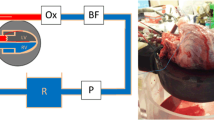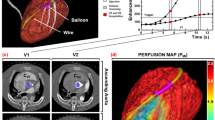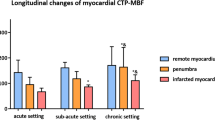Abstract
We validated a CT Perfusion technique with beam hardening (BH) correction for quantitative measurement of myocardial blood flow (MBF). Acute myocardial infarction (AMI) was created in four pigs by occluding the distal LAD for 1 h followed by reperfusion. MBF was measured from dynamic contrast enhanced CT (DCE-CT) scanning of the heart, with correction of cardiac motion and BH, before ischemic insult and on day 7, 10 and 14 post. On day 14 post, radiolabeled microspheres were injected to measure MBF and the results were compared with those measured by CT Perfusion. Excised hearts were stained with 2,3,5-triphenyltetrazolium chloride (TTC) to determine the relationship between MBF measured by CT Perfusion and myocardial viability. MBF measured by CT Perfusion was strongly correlated with that by microspheres over a wide range of MBF values (R = 0.81, from 25 to 225 ml min−1 100 g−1). While MBF in the LAD territory decreased significantly from 98.4 ± 2.5 ml min−1 100 g−1 at baseline to 32.2 ± 9.1 ml min−1 100 g−1, P < 0.05 at day 7 and to 49.4 ± 9.3 ml min−1 100 g−1, P < 0.05 at day 14, the decrease in remote myocardium (LCx territory) from baseline (103.9 ± 1.9 ml min−1 100 g−1) was minimal throughout the study (90.6 ± 5.1 ml min−1 100 g−1 on day 14 post, P > 0.05). TTC staining confirmed incomplete infarction in the LAD territory and no infarction in the LCx territory. Microvascular obstruction in infarcted tissue resulted in no-reflow and hence persistently low MBF in the reperfused LAD territory which contained a mixture of viable and non-viable tissue. CT Perfusion measurement of MBF was accurate and correlated well with histology and microspheres measurements.





Similar content being viewed by others
References
Miller JM, Rochitte CE, Dewey M et al (2008) Diagnostic performance of coronary angiography by 64-row CT. N Engl J Med 359(22):2324–2336
George RT, Silva C, Cordeiro MA et al (2006) Multidetector computed tomography myocardial perfusion imaging during adenosine stress. J Am Coll Cardiol 48(1):153–160
George RT, Jerosch-Herold M, Silva C et al (2007) Quantification of myocardial perfusion using dynamic 64-detector computed tomography. Invest Radiol 42(12):815–822
Blankstein R, Shturman LD, Rogers IS et al (2009) Adenosine-induced stress myocardial perfusion imaging using dual-source cardiac computed tomography. J Am Coll Cardiol 54(12):1072–1084
Bastarrika G, Ramos-Duran L, Rosenblum MA et al (2010) Adenosine-stress dynamic myocardial CT perfusion imaging: initial clinical experience. Invest Radiol 45(6):306–313
Mahnken AH, Klotz E, Pietsch H et al (2010) Quantitative whole heart stress perfusion CT imaging as noninvasive assessment of hemodynamics in coronary artery stenosis: preliminary animal experience. Invest Radiol 45(6):298–305
Ho KT, Chua KC, Klotz E et al (2010) Stress and rest dynamic myocardial perfusion imaging by evaluation of complete time-attenuation curves with dual-source CT. JACC Cardiovasc Imaging 3(8):811–820
Lee TY (2002) Functional CT: physiological models. Trends Biotechnol 20(Suppl):S3–S10
Lee TY, Purdie TG, Stewart E (2003) CT imaging of angiogenesis. Q J Nucl Med 47(3):171–187
So A, Hsieh J, Li JY et al (2009) Beam hardening correction in CT myocardial perfusion measurement. Phys Med Biol 54(10):3031–3050
So A, Adam V, Acharya K et al (2003) Manual and semi-automatic segmentation versus retrospective ECG gating for correction of cardiac motion. SPIE Med Imaging Proc 5031:493–503
Cenic A, Nabavi DG, Craen RA et al (2000) A CT method to measure hemodynamics in brain tumors: validation and application of cerebral blood flow maps. AJNR Am J Neuroradiol 21(3):462–470
Murphy BD, Fox AJ, Lee DH et al (2008) White matter thresholds for ischemic penumbra and infarct core in patients with acute stroke: CT perfusion study. Radiology 247(3):818–825
Meier P, Zierler KL (1954) On the theory of the indicator-dilution method for measurement of blood flow and volume. J Appl Physiol 6(12):731–744
Bassingthwaighte JB, Knopp TJ, Anderson DU (1970) Flow estimation by indicator dilution (bolus injection). Circ Res 27(2):277–291
Johnson JA, Wilson TA (1966) A model for capillary exchange. Am J Physiol 210(6):1299–1303
St Lawrence KS, Lee TY (1998) An adiabatic approximation to the tissue homogeneity model for water exchange in the brain: I. Theoretical derivation. J Cereb Blood Flow Metab 18(12):1365–1377
Alexander CS, Liu SM (1976) Effect of hypercapnia and hypocapnia on myocardial blood flow and performance in anaesthetized dogs. Cardiovasc Res 10(3):341–348
Eliades D, Weiss HR (1986) Effect of hypercapnia on coronary circulation. Cardiovasc Res 20(2):127–133
Heymann MA, Payne BD, Hoffman JI et al (1977) Blood flow measurements with radionuclide-labeled particles. Prog Cardiovasc Dis 20(1):55–79
Cerqueira MD, Weissman NJ, Dilsizian V et al (2002) Standardized myocardial segmentation and nomenclature for tomographic imaging of the heart: a statement for healthcare professionals from the cardiac imaging committee of the council on clinical cardiology of the American heart association. Circulation 105(4):539–542
Geleijnse ML, Fioretti PM, Roelandt JR (1997) Methodology, feasibility, safety and diagnostic accuracy of dobutamine stress echocardiography. J Am Coll Cardiol 30(3):595–606
Ambrosio G, Weisman HF, Mannisi JA et al (1989) Progressive impairment of regional myocardial perfusion after initial restoration of postischemic blood flow. Circulation 80(6):1846–1861
Kloner RA, Ganote CE, Jennings RB (1974) The “no-reflow” phenomenon after temporary coronary occlusion in the dog. J Clin Invest 54(6):1496–1508
Kloner RA, Rude RE, Carlson N et al (1980) Ultrastructural evidence of microvascular damage and myocardial cell injury after coronary artery occlusion: which comes first? Circulation 62(5):945–952
Manciet LH, Poole DC, McDonagh PF et al (1994) Microvascular compression during myocardial ischemia: mechanistic basis for no-reflow phenomenon. Am J Physiol 266(4 Pt 2):H1541–H1550
Bolli R, Triana JF, Jeroudi MO (1990) Prolonged impairment of coronary vasodilation after reversible ischemia. Evidence for microvascular “stunning”. Circ Res 67(2):332–343
Hausleiter J, Meyer T, Hermann F et al (2009) Estimated radiation dose associated with cardiac CT angiography. JAMA 301(5):500–507
Thibault JB, Sauer KD, Bouman CA et al (2007) A three-dimensional statistical approach to improved image quality for multislice helical CT. Med Phys 34(11):4526–4544
Alvarez RE, Macovski A (1976) Energy-selective reconstructions in X-ray computerized tomography. Phys Med Biol 21(5):733–744
Kalender WA, Perman WH, Vetter JR et al (1986) Evaluation of a prototype dual-energy computed tomographic apparatus. I. Phantom studies. Med Phys 13(3):334–339
Francone M, Carbone I, Danti M et al (2006) ECG-gated multi-detector row spiral CT in the assessment of myocardial infarction: correlation with non-invasive angiographic findings. Eur Radiol 16(1):15–24
Bassingthwaighte JB, Wang CY, Chan IS (1989) Blood-tissue exchange via transport and transformation by capillary endothelial cells. Circ Res 65(4):997–1020
Hawkins DM (2004) The problem of overfitting. J Chem Inf Comput Sci 44(1):1–12
Schmitt M, Horstick G, Petersen SE et al (2005) Quantification of resting myocardial blood flow in a pig model of acute ischemia based on first-pass MRI. Magn Reson Med 53(5):1223–1227
Kroll K, Wilke N, Jerosch-Herold M et al (1996) Modeling regional myocardial flows from residue functions of an intravascular indicator. Am J Physiol 271(4 Pt 2):H1643–H1655
Jerosch-Herold M, Wilke N, Stillman AE (1998) Magnetic resonance quantification of the myocardial perfusion reserve with a fermi function model for constrained deconvolution. Med Phys 25(1):73–84
Acknowledgments
This work is supported in part by grants from the Canadian Institutes of Health Research (CIHR), Ontario Research Fund (ORF), Ontario Innovation Trust (OIT) and GE Healthcare (GEHC).
Conflict of interest
Drs. Jiang Hsieh and Jian-Ying Li are employees of GE Healthcare. Dr. Ting-Yim Lee is a grant recipient of and consultant to GE Healthcare. Other authors have no disclosures.
Author information
Authors and Affiliations
Corresponding author
Rights and permissions
About this article
Cite this article
So, A., Hsieh, J., Li, JY. et al. Quantitative myocardial perfusion measurement using CT Perfusion: a validation study in a porcine model of reperfused acute myocardial infarction. Int J Cardiovasc Imaging 28, 1237–1248 (2012). https://doi.org/10.1007/s10554-011-9927-x
Received:
Accepted:
Published:
Issue Date:
DOI: https://doi.org/10.1007/s10554-011-9927-x




